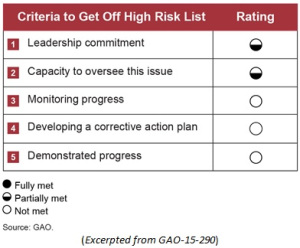(Not) Taking Care of Business at DOD
Defending the nation involves much more than combat and weaponry. The Department of Defense spends billions each year managing the business side of its operations. And like the threats to our nation, the nature of business is constantly evolving. That’s one key reason why DOD’s approach to business transformation has been on our High Risk List since 2005. Today’s WatchBlog explores what that means, and why it remains on the list today.
Business transformation: more than meets the eye
DOD’s business functions include managing contracts, finances, supply chain, support infrastructure, and weapons systems acquisitions. If these operations don’t run smoothly, neither does the military. Moreover, inefficiencies can burn resources needed elsewhere, directly affecting the readiness and capabilities of U.S. forces.
When we talk about “business transformation” what we mean is improving and integrating processes and systems to ensure they work together seamlessly. A “transformed” DOD would have
- processes that effectively track staff, inventory, and spending;
- IT systems that share information so staff have what they need and don’t duplicate each other’s work; and
- accountable leaders with long-term strategies and the information needed to benchmark and achieve their goals.
Not having consistent and effective processes and systems, combined with the size of DOD’s budget, makes DOD’s key business functions highly vulnerable to fraud, waste, abuse, and mismanagement.
Some work to do
Since 2005, Congress and DOD have tried to improve DOD’s business transformation efforts. These primarily relate to creating leadership positions that plan for and address business challenges. For example, DOD leaders established the Defense Business Council to monitor performance and progress across business operations and issued related guidance. DOD also reported savings from some business systems.
Yet major actions are still needed. DOD hasn’t prioritized its business functions, leaders aren’t held accountable for their progress (or lack thereof), and the department isn’t examining what led to previous problems so it can address them. Moreover, the office that oversees these efforts doesn’t have the information it needs to move forward.
We issue updates to our High Risk List every 2 years. Each time we do so, we track agency progress and, once all the fundamental aspects of an issue are addressed, we remove it from the list.
Comments on GAO’s WatchBlog? Contact blog@gao.gov.





